Landslide Susceptibility Analysis Based on Dataset Construction of Landslides in Yiyang Using GIS and Machine Learning
Abstract
1. Introduction
2. Overview of the Study Area
2.1. Study Area
2.2. Methodology
2.3. Investigation of Landslides
3. Dataset Construction of Landslides in Yiyang City
3.1. Data Sources
3.2. Extraction of Landslide Predisposing Factors
3.2.1. Geological Factors
3.2.2. Topographical Factors
3.2.3. Environmental Factors
3.2.4. Hydrological and Meteorological Factors
3.3. Generation of Data Samples
3.4. Selection of Predisposing Factors
4. Blending Ensemble Learning-Based Landslide Susceptibility Mapping and Risk Assessment
4.1. Optimization Method Based on Blending Ensemble Learning
4.1.1. A Brief Introduction to XGBoost Algorithm
4.1.2. Random Forest
4.1.3. CatBoost
4.1.4. Blending Ensemble Model
4.2. Evaluation of Model Accuracy
4.3. Application and Evaluation of Blending Ensemble Model
4.3.1. Sample Training
Target Encoding
4.3.2. Weight Analysis of Landslide Predisposing Factors and Model Reliability Testing
4.3.3. Analysis of the Results
4.4. Landslide Susceptibilty Mapping and Risk Assessment Based on Weighted Information Entropy
4.4.1. Calculation of Information Values of Predisposing Factors
4.4.2. Analysis of Landslide Susceptibility Based on Blending Ensemble Model
4.4.3. Landslide Risk Zoning Based on the Blending Ensemble Model
4.5. Validation of Landslide Risk Zoning Results
5. Discussion
6. Conclusions
Author Contributions
Funding
Data Availability Statement
Acknowledgments
Conflicts of Interest
References
- Froude, M.J.; Petley, D.N. Global fatal landslide occurrence from 2004 to 2016. Nat. Hazards Earth Syst. Sci. 2018, 18, 2161–2181. [Google Scholar] [CrossRef]
- Pham, B.T.; Jaafari, A.; Nguyen-Thoi, T.; Van Phong, T.; Nguyen, H.D.; Satyam, N.; Masroor; Rehman, S.; Sajjad, H.; Sahana, M.; et al. Ensemble machine learning models based on Reduced Error Pruning Tree for prediction of rainfall-induced landslides. Int. J. Digit. Earth 2020, 14, 575–596. [Google Scholar] [CrossRef]
- Available online: https://yjt.hunan.gov.cn/yjt/tszt/ywzl/dzdz/202305/t20230506_29330937.html (accessed on 6 May 2023).
- Liu, L.L.; Danish, A.; Wang, X.M.; Zhu, W.Q. Ensemble stacking: A powerful tool for landslide susceptibility assessment—A case study in Anhua County, Hunan Province, China. Geocarto Int. 2024, 39, 2326005. [Google Scholar] [CrossRef]
- Feizizadeh, B.; Blaschke, T. An uncertainty and sensitivity analysis approach for GIS-based multicriteria landslide susceptibility mapping. Int. J. Geogr. Inf. Sci. 2014, 28, 610–638. [Google Scholar] [CrossRef] [PubMed]
- Arabameri, A.; Chandra Pal, S.; Rezaie, F.; Chakrabortty, R.; Saha, A.; Blaschke, T.; Di Napoli, M.; Ghorbanzadeh, O.; Ngo, P.T.T. Decision tree based ensemble machine learning approaches for landslide susceptibility mapping. Geocarto Int. 2022, 37, 4594–4627. [Google Scholar] [CrossRef]
- Achour, Y.; Boumezbeur, A.; Hadji, R.; Chouabbi, A.; Cavaleiro, V.; Bendaoud, E.A. Landslide susceptibility mapping using analytic hierarchy process and information value methods along a highway road section in Constantine, Algeria. Arab. J. Geosci. 2017, 10, 194. [Google Scholar] [CrossRef]
- Dehnavi, A.; Aghdam, I.N.; Pradhan, B.; Varzandeh, M.H. A new hybrid model using Step-wise Weight Assessment Ratio Analysis (SWARA) technique and Adaptive Neuro-fuzzy Inference System (ANFIS) for regional landslide hazard assessment in Iran. Catena 2015, 135, 122–148. [Google Scholar] [CrossRef]
- Xiong, C.; Cui, F.; Liu, J.; Li, N.; Jie, R.; Meng, F. Formation mechanism and stability analysis of the DR landslide in national road 534 of Datian, Sanming, Fujian Province, China. Geomat. Nat. Hazards Risk 2021, 12, 3317–3345. [Google Scholar] [CrossRef]
- Seddiki, A.; Khemissa, M. Seismic stability analysis of a pre-cracked natural slope: A case study of Aomar slope in Algeria. Geomech. Geoengin. 2019, 16, 52–66. [Google Scholar] [CrossRef]
- Sepe, C.; Confuorto, P.; Angrisani, A.C.; Di Martire, D.; Di Napoli, M.; Calcaterra, D. Application of a statistical approach to landslide susceptibility map generation in urban settings. In IAEG/AEG Annual Meeting Proceedings; Shakoor, A., Cato, K., Eds.; Springer International: Cham, Switzerland, 2019; Volume 1, pp. 155–162. [Google Scholar] [CrossRef]
- Di Napoli, M.; Carotenuto, F.; Cevasco, A.; Confuorto, P.; Di Martire, D.; Firpo, M.; Pepe, G.; Raso, E.; Calcaterra, D. Machine learning ensemble modelling as a tool to improve landslide susceptibility mapping reliability. Landslides 2020, 17, 1897–1914. [Google Scholar] [CrossRef]
- Reichenbach, P.; Rossi, M.; Malamud, B.D.; Mihir, M.; Guzzetti, F. A review of statistically-based landslide susceptibility models. Earth-Sci. Rev. 2018, 180, 60–91. [Google Scholar] [CrossRef]
- Wang, H.J.; Xiao, T.; Li, X.Y.; Zhang, L.L.; Zhang, L.M. A novel physically-based model for updating landslide susceptibility. Eng. Geol. 2019, 251, 71–80. [Google Scholar] [CrossRef]
- Peng, L.; Sun, Y.; Zhan, Z.; Shi, W.; Zhang, M. FR-weighted GeoDetector for landslide susceptibility and driving factors analysis. Geomat. Nat. Hazards Risk 2023, 14, 2205001. [Google Scholar] [CrossRef]
- Liu, L.; Deng, J. Multi-model combination in key steps for landslide susceptibility modeling and uncertainty analysis: A case study in Baoji City, China. Geomat. Nat. Hazards Risk 2024, 15, 2344804. [Google Scholar] [CrossRef]
- Taalab, K.; Cheng, T.; Zhang, Y. Mapping landslide susceptibility and types using Random Forest. Big Earth Data 2018, 2, 159–178. [Google Scholar] [CrossRef]
- Bernat Gazibara, S.; Sinčić, M.; Krkač, M.; Lukačić, H.; Mihalić Arbanas, S. Landslide susceptibility assessment on a large scale in the Podsljeme area, City of Zagreb (Croatia). J. Maps 2023, 19, 2163197. [Google Scholar] [CrossRef]
- Saha, A.; Villuri, V.G.K.; Bhardwaj, A.; Kumar, S. A Multi-Criteria Decision Analysis (MCDA) Approach for Landslide Susceptibility Mapping of a Part of Darjeeling District in North-East Himalaya, India. Appl. Sci. 2023, 13, 5062. [Google Scholar] [CrossRef]
- Mario, B.; Giacomo, P.; Paola, G.; Giuseppe, P.; Marco, P.; Katia, S.; Francesco, C. Landslides and predisposing factors of the Southern Apennines, Italy. J. Maps 2022, 19, 2137065. [Google Scholar] [CrossRef]
- Huang, X.; Xiong, Y.; Li, H. Sensitivity analysis of landslide based on BP neural network in Yiyang City, Hunan Province. Urban Geol. 2023, 18, 8–14. [Google Scholar]
- Liu, L.L.; Yang, C.; Huang, F.M.; Wang, X.M. Landslide susceptibility mapping by attentional factorization machines considering feature interactions. Geomat. Nat. Hazards Risk. 2021, 12, 1837–1861. [Google Scholar] [CrossRef]
- Liu, L.L.; Yang, C.; Wang, X.M. Landslide susceptibility assessment using feature selection-based machine learning models. Geomech. Eng. 2021, 25, 1–16. [Google Scholar] [CrossRef]
- Youssef, A.M.; Pourghasemi, H.R.; Pourtaghi, Z.S.; Al-Katheeri, M.M. Landslide susceptibility mapping using random forest, boosted regression tree, classification and regression tree, and general linear models and comparison of their performance at Wadi Tayyah Basin, Asir Region, Saudi Arabia. Landslides 2016, 13, 839–856. [Google Scholar] [CrossRef]
- Li, C.Y.; Wang, X.C.; He, C.Z.; Wu, X.; Kong, Z.Y.; Li, X.L. Spatial Database of the National 1:200,000 Digital Geological Map (Public Version) (V1). Development Research Center of China Geological Survey; China Geological Survey [Founding Organization], 1957. National Geological Information Center [Dissemination Organization], 30 June 2019. Available online: http://geochina.cgs.gov.cn/article/doi/10.12029/gc2019Z101?viewType=citedby-info (accessed on 30 November 2019).
- Yi, Y.; Zhang, Z.; Zhang, W.; Xu, Q.; Deng, C.; Li, Q. GIS-based Earthquake-Triggered-Landslide Susceptibility Mapping with an Integrated Weighted Index Model in Jiuzhaigou Region of Sichuan Province, China. Nat. Hazards Earth Syst. Sci. 2019, 19, 1973–1988. [Google Scholar] [CrossRef]
- Ben, Y.; Yi, W.; Huang, X.; Huang, X.; Li, H.; Liu, W. Influence of prophase rainfall pattern-based study on rainfall threshold for monitoring and earlywarning of No.1 landslide at Machi Village on left bank of Duhe River: A Hanjiang River tributary. Water Resour. Hydropower Eng. 2023, 54, 38–50. [Google Scholar] [CrossRef]
- Dou, J.; Yunus, A.P.; Merghadi, A.; Shirzadi, A.; Nguyen, H.; Hussain, Y.; Avtar, R.; Chen, Y.; Pham, B.T.; Yamagishi, H. Different Sampling Strategies for Predicting Landslide Susceptibilities are Deemed Less Consequential with Deep Learning. Sci. Total Environ. 2020, 720, 137320. [Google Scholar] [CrossRef] [PubMed]
- Yi, Y.; Zhang, W.; Xu, X.; Zhang, Z.; Wu, X. Evaluation of neural network models for landslide susceptibility assessment. Int. J. Digit. Earth 2022, 15, 934–953. [Google Scholar] [CrossRef]
- Rabby, Y.W.; Hossain, M.B.; Abedin, J. Landslide susceptibility mapping in three Upazilas of Rangamati hill district Bangladesh: Application and comparison of GIS-based machine learning methods. Geocarto Int. 2021, 37, 3371–3396. [Google Scholar] [CrossRef]
- Quevedo, R.P.; Maciel, D.A.; Uehara, T.D.T.; Vojtek, M.; Rennó, C.D.; Pradhan, B.; Vojteková, J.; Pham, Q.B. Consideration of spatial heterogeneity in landslide susceptibility mapping using geographical random forest model. Geocarto Int. 2021, 37, 8190–8213. [Google Scholar] [CrossRef]
- Zhu, Q.; Zhang, M.; Ding, Y.; Zeng, H.; Wang, W.; Liu, F. Fuzzy logic analysis method for regional landslide sensitivity constrained by spatial characteristics of environmental factors. J. Wuhan Univ. Inf. Sci. Ed. 2021, 46, 1431–1440. [Google Scholar]
- Chen, Z. Research on the Evaluation Model and Application of Geological Disaster Susceptibility Based on Integrated Machine Learning. Master’s Thesis, Lanzhou University of Technology, Lanzhou, China, 2023. [Google Scholar] [CrossRef]
- Li, Y.; Wang, H.; Jin, X. Self-organizing Neural Network Algorithm Based on Random Forest Optimization. J. Jilin Univ. Sci. Ed. 2021, 59, 351–358. [Google Scholar]
- Li, G.; Liu, P.; Zhang, K.; Wu, Q.; Li, Y. Analysis of the Influence of Dimension Unification in the Evaluation of Landslide Susceptibility. Hydrogeol. Eng. Geol. 2024, 51, 118–129. [Google Scholar] [CrossRef]
- Friedman, J.H. Stochastic gradient boosting. Comput. Stat. Data Anal. 2002, 38, 367–378. [Google Scholar] [CrossRef]
- Shi, Q.; Yang, L.; Lei, P.; Xu, H. Research and Implementation of Text Resource Classification Method for Thematic Databases Based on Blending Ensemble Learning. Intell. Theory Pract. 2022, 45, 169–175. [Google Scholar]
- Khosravi, K.; Pham, B.T.; Chapi, K.; Shirzadi, A.; Shahabi, H.; Revhaug, I.; Prakash, I.; Bui, D.T. A comparative assessment of decision trees algorithms for flash flood susceptibility modeling at Haraz watershed, northern Iran. Sci Total Environ. 2018, 627, 744–755. [Google Scholar] [CrossRef] [PubMed]
- Agrawal, N.; Dixit, J. Assessment of landslide susceptibility for Meghalaya (India) using bivariate (frequency ratio and Shannon entropy) and multi-criteria decision analysis (AHP and fuzzy-AHP) models. All Earth. 2022, 34, 179–201. [Google Scholar] [CrossRef]
- Hong, H.; Wang, D.; Zhu, A.; Wang, Y. Landslide susceptibility mapping based on the reliability of landslide and non-landslide sample. Expert Syst. Appl. 2023, 243, 122933. [Google Scholar] [CrossRef]
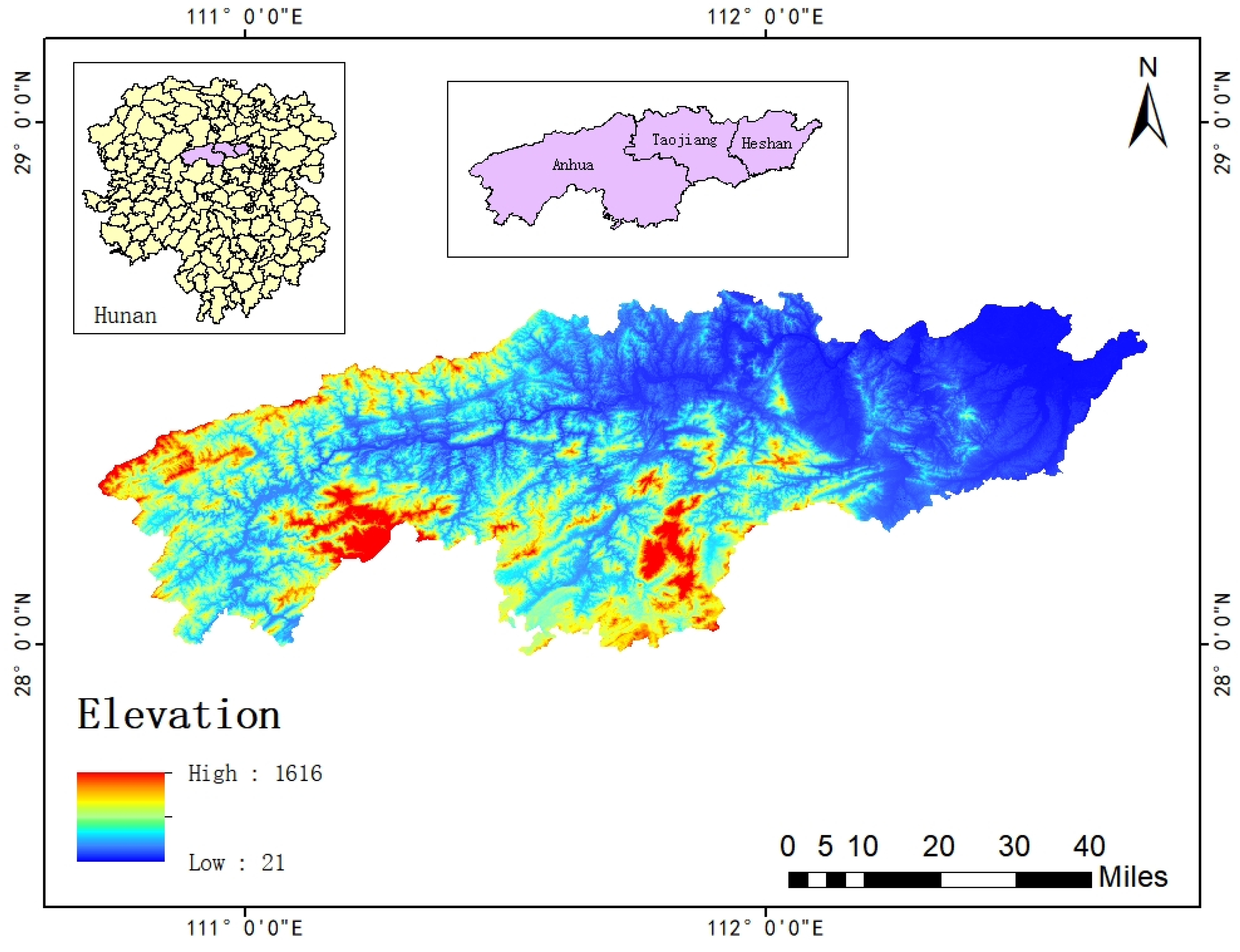
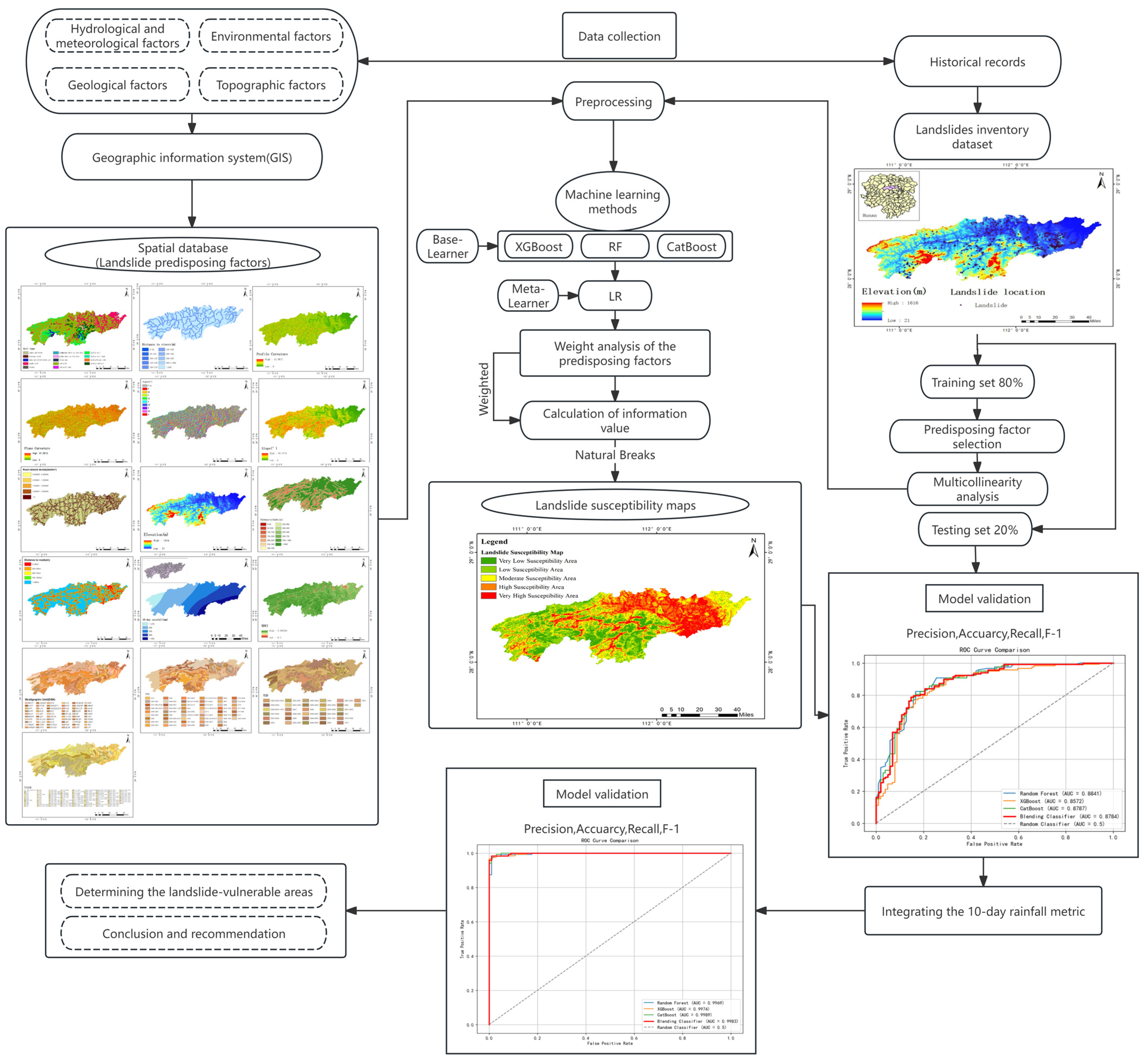
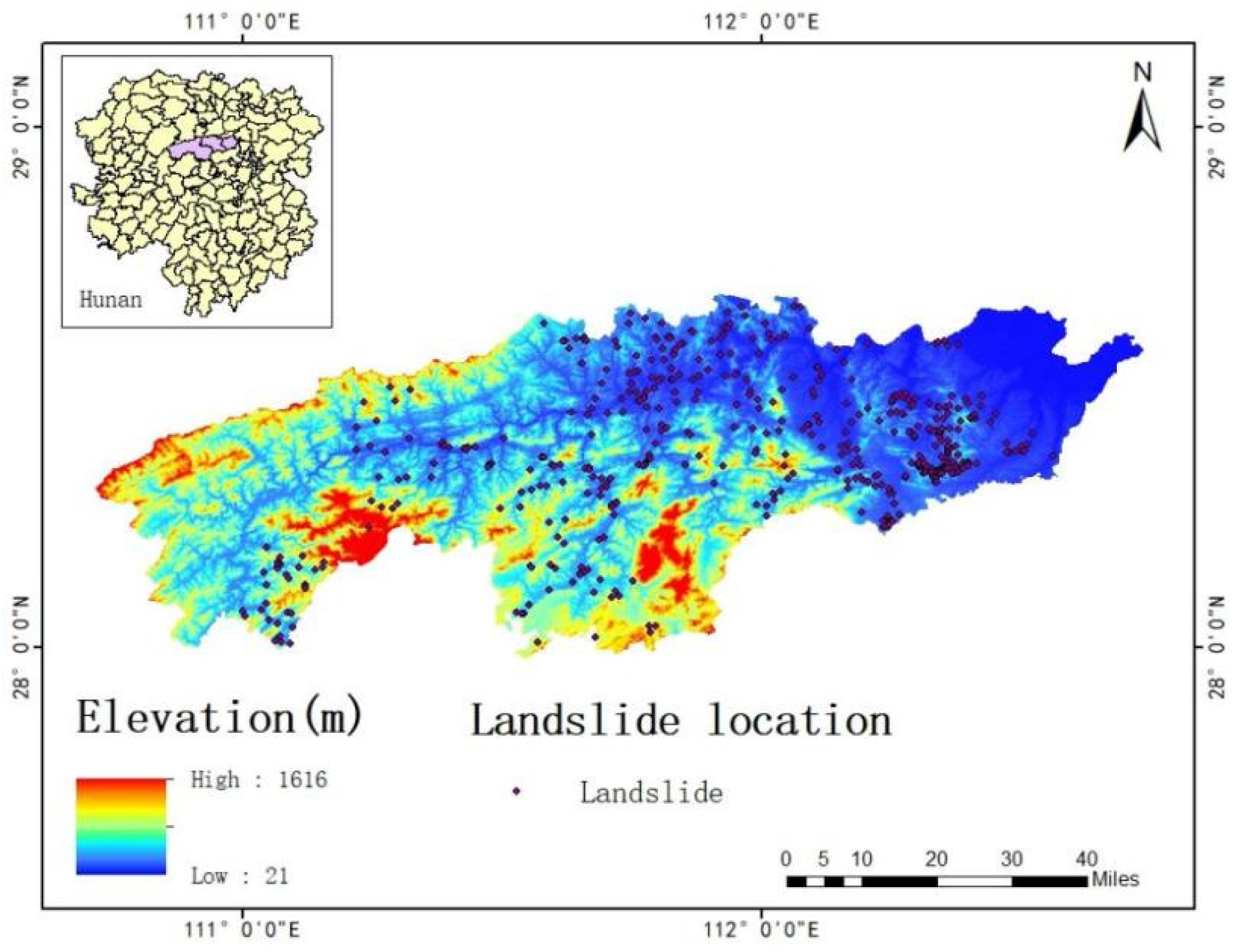
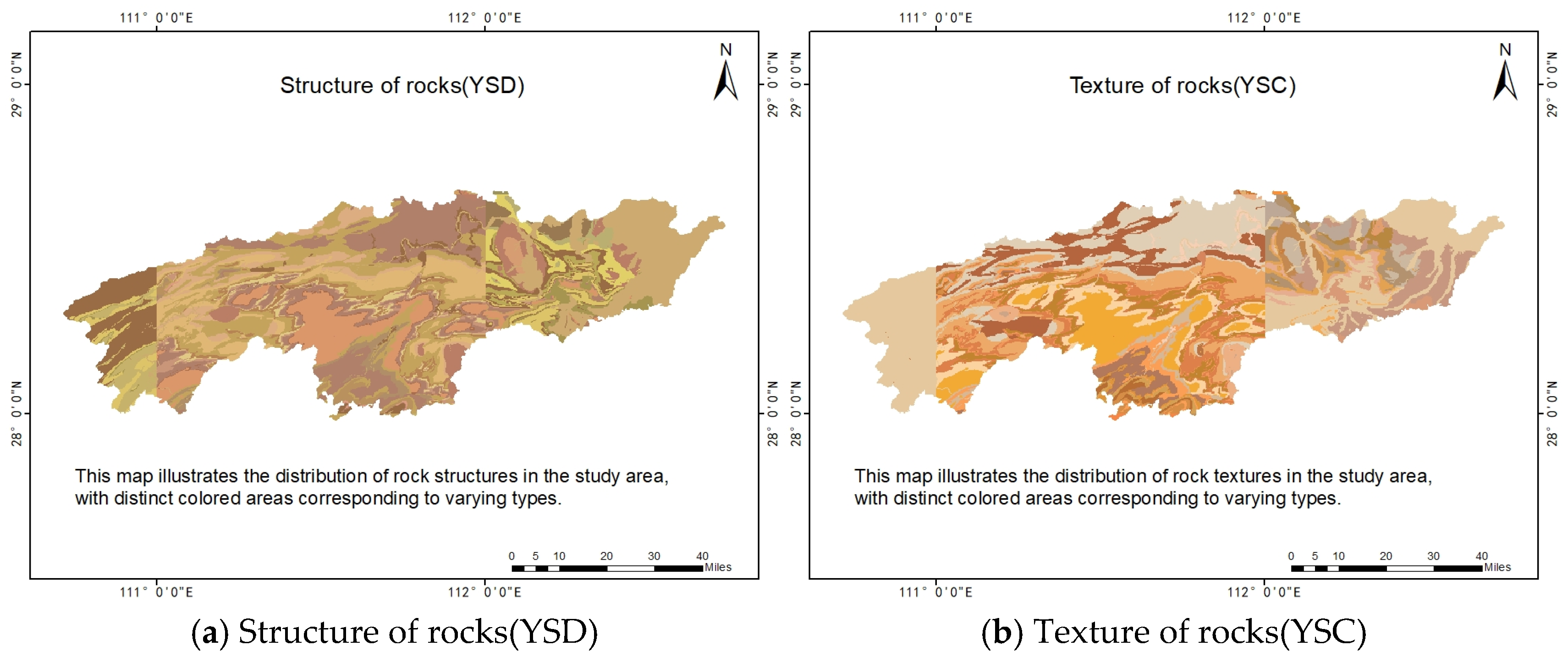
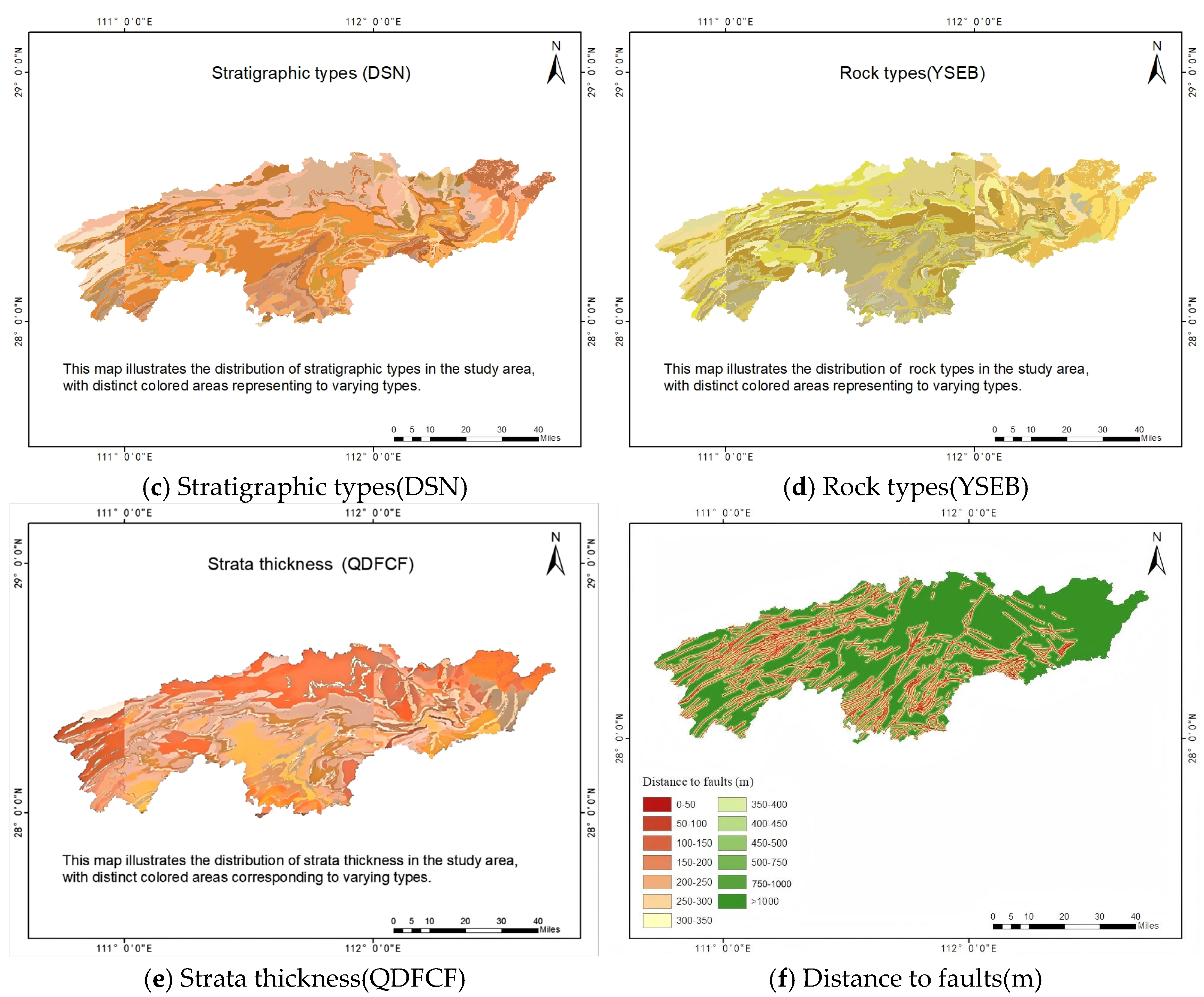
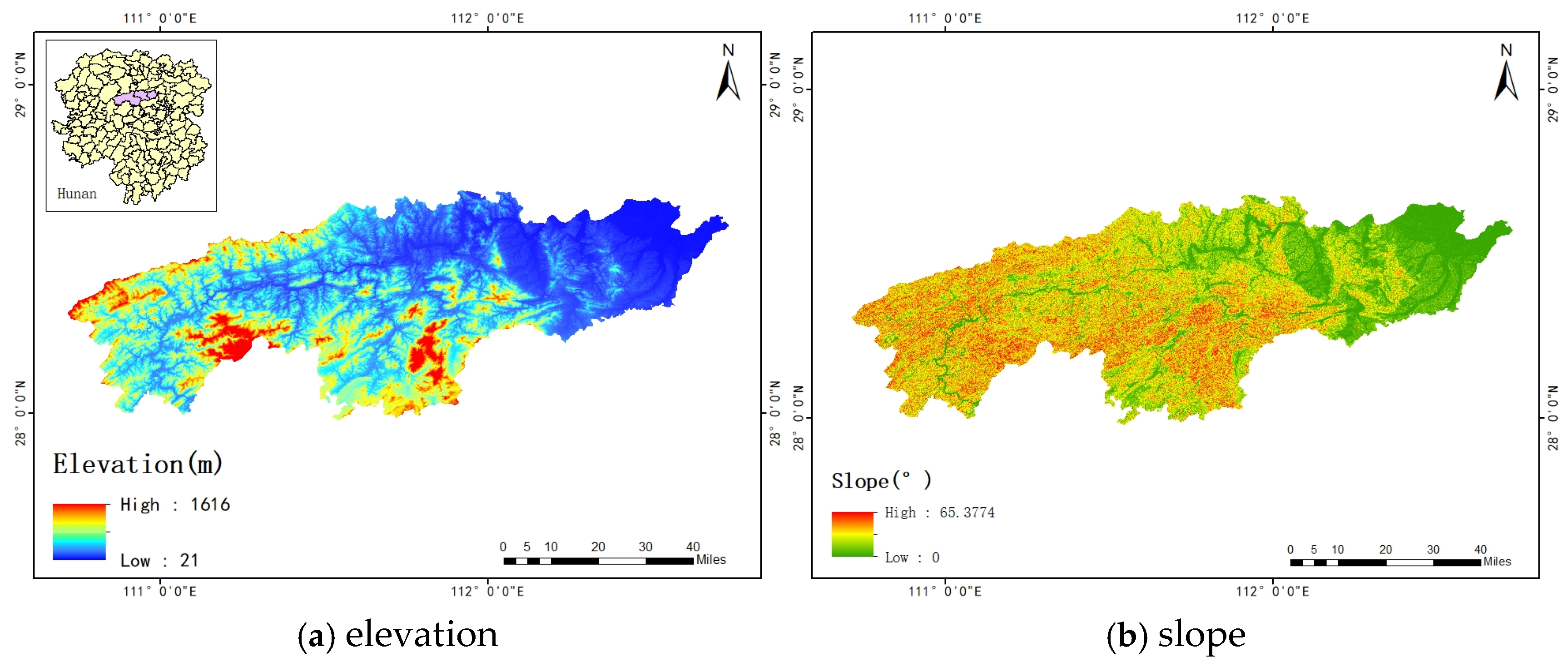
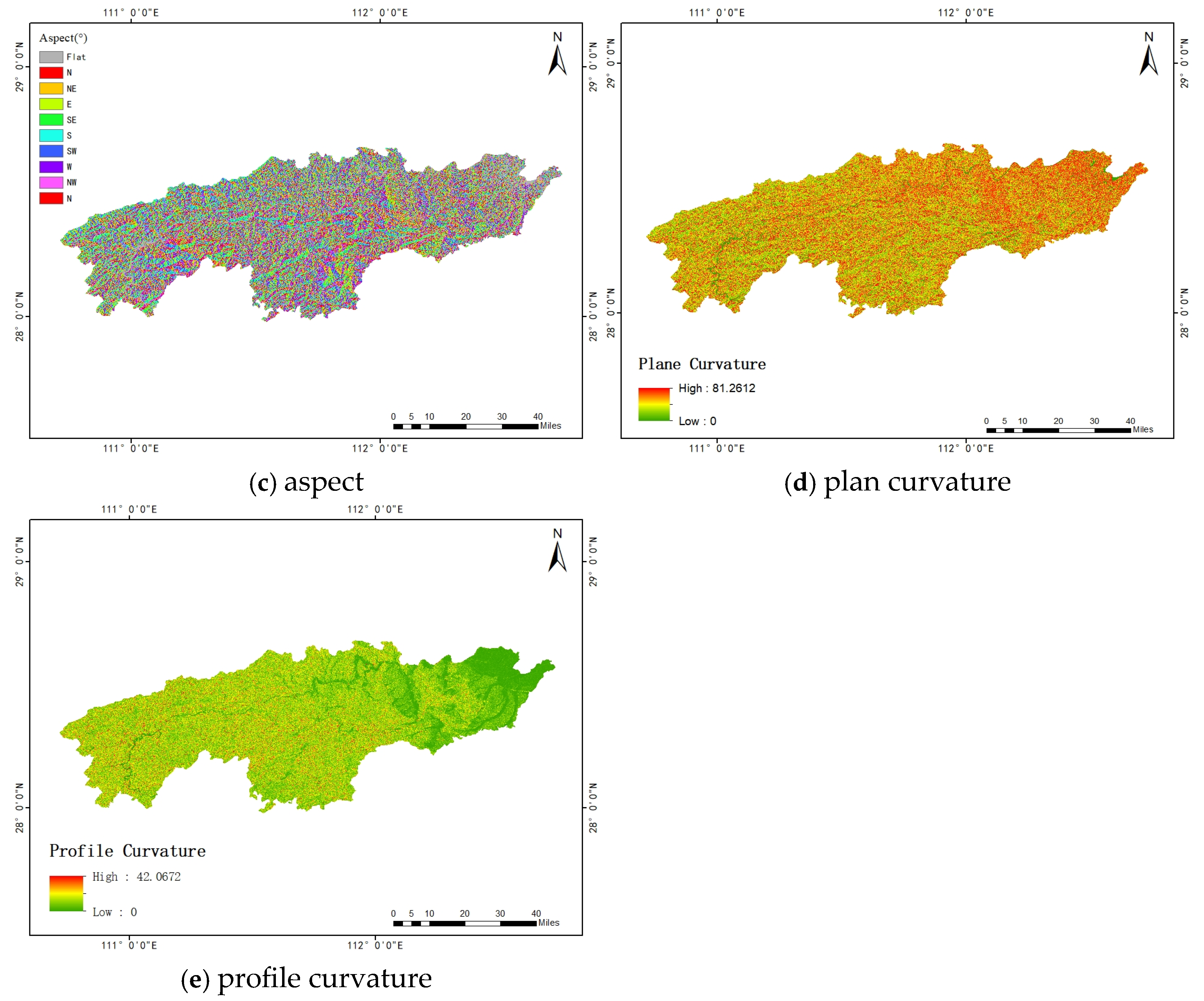
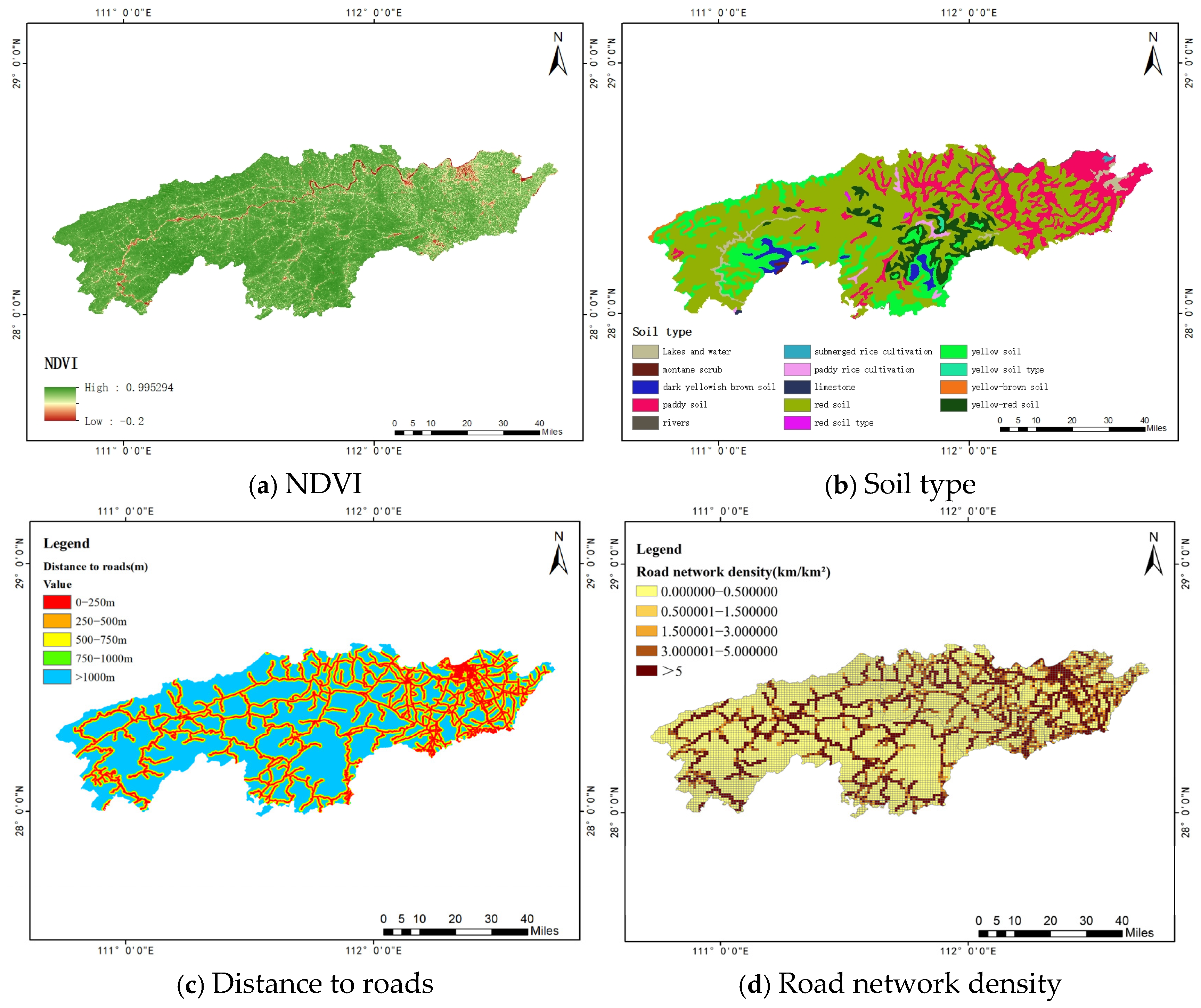
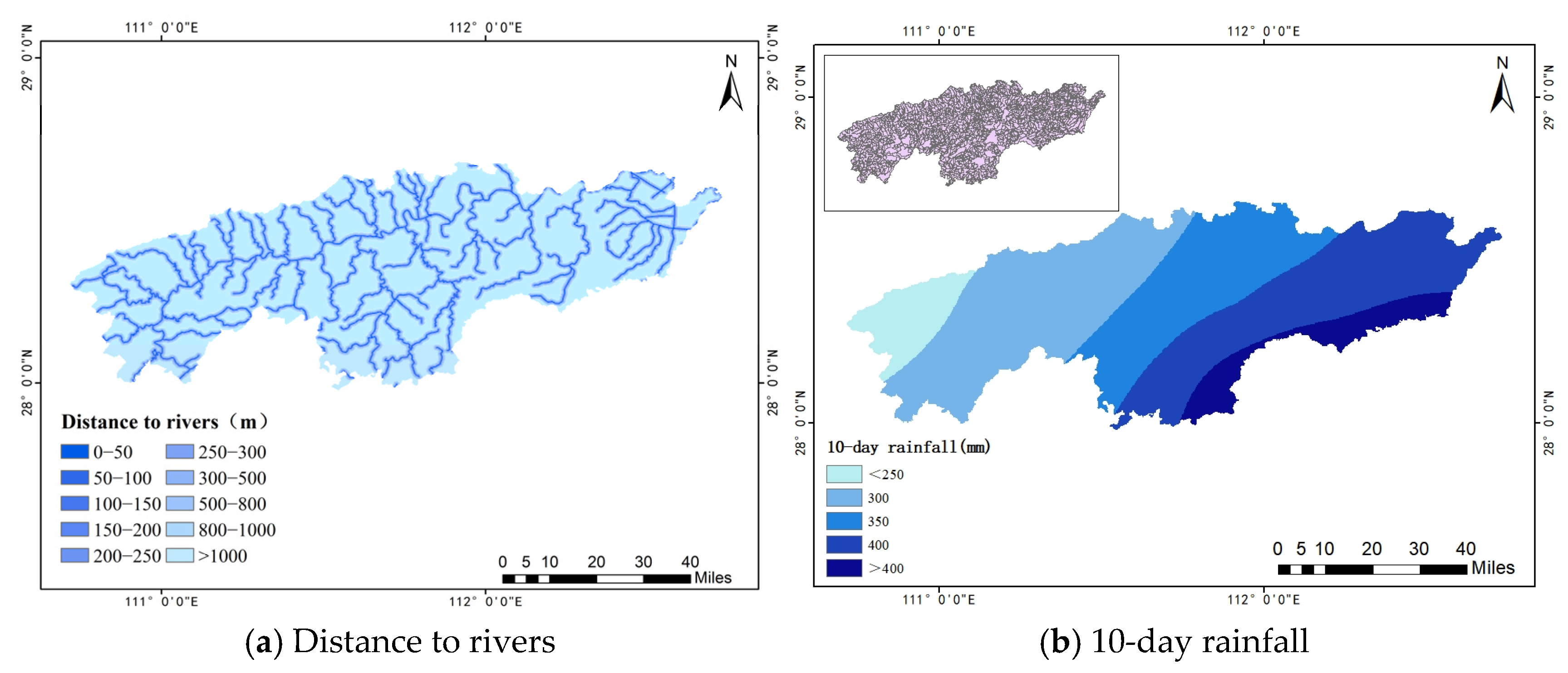


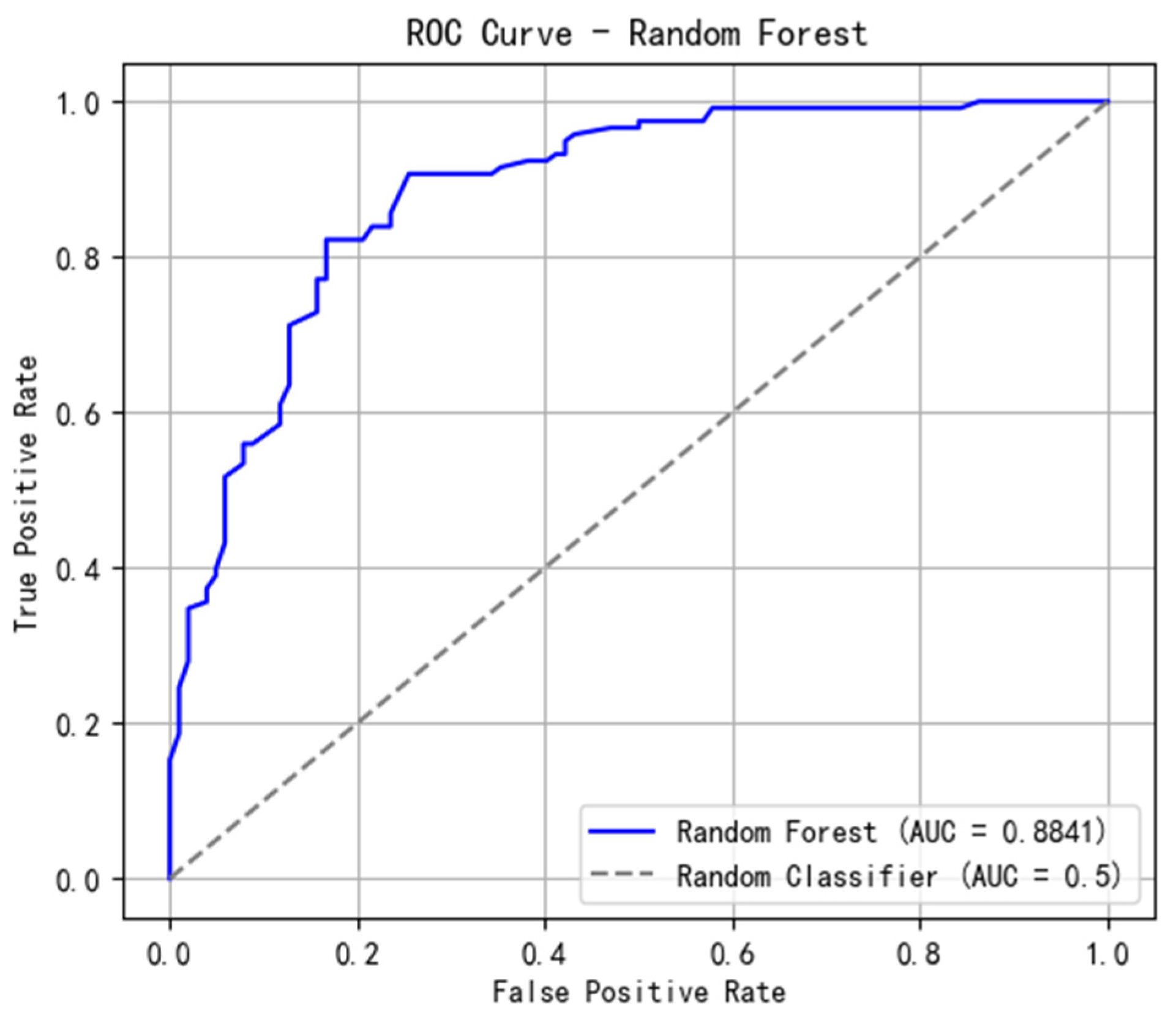



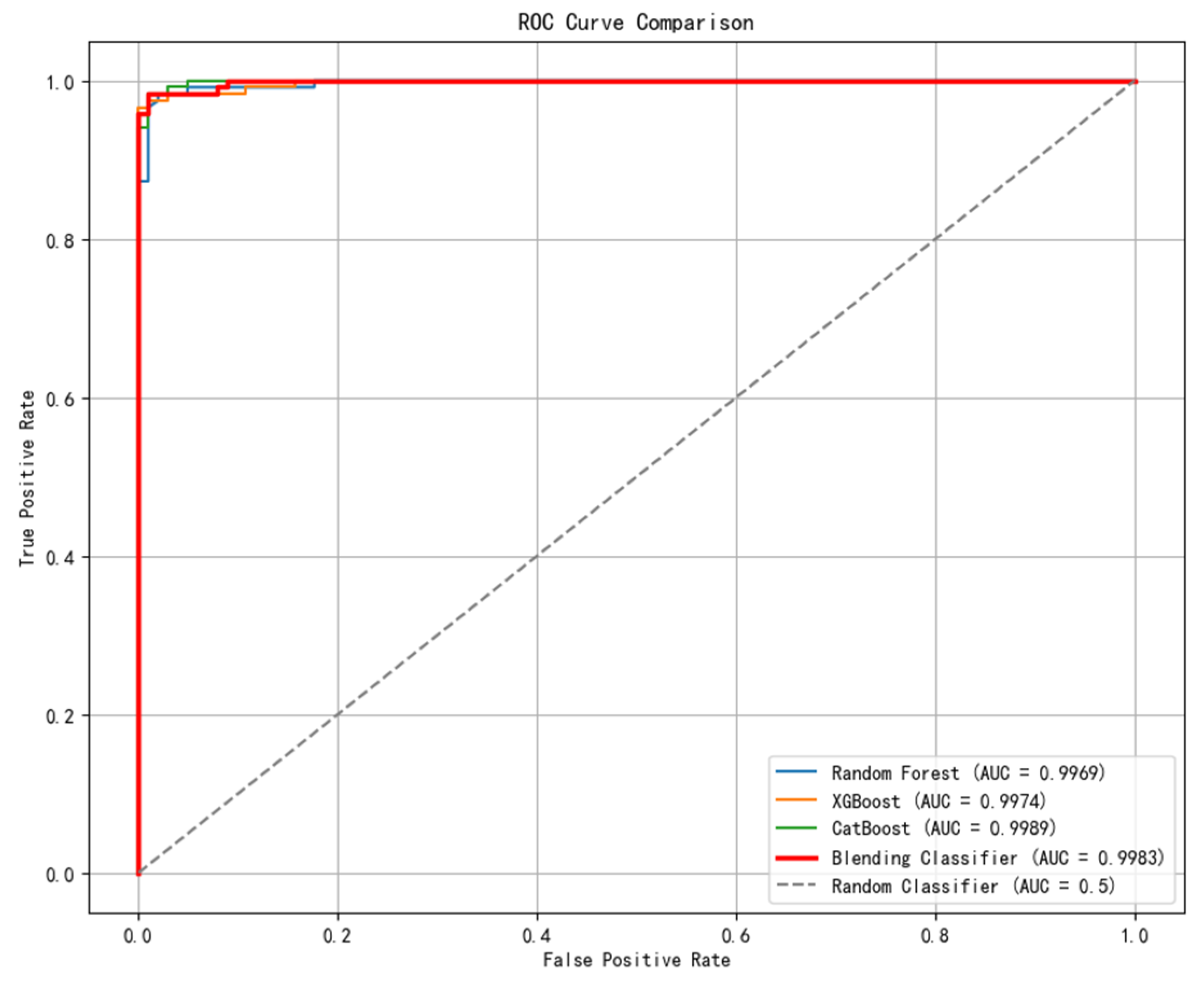

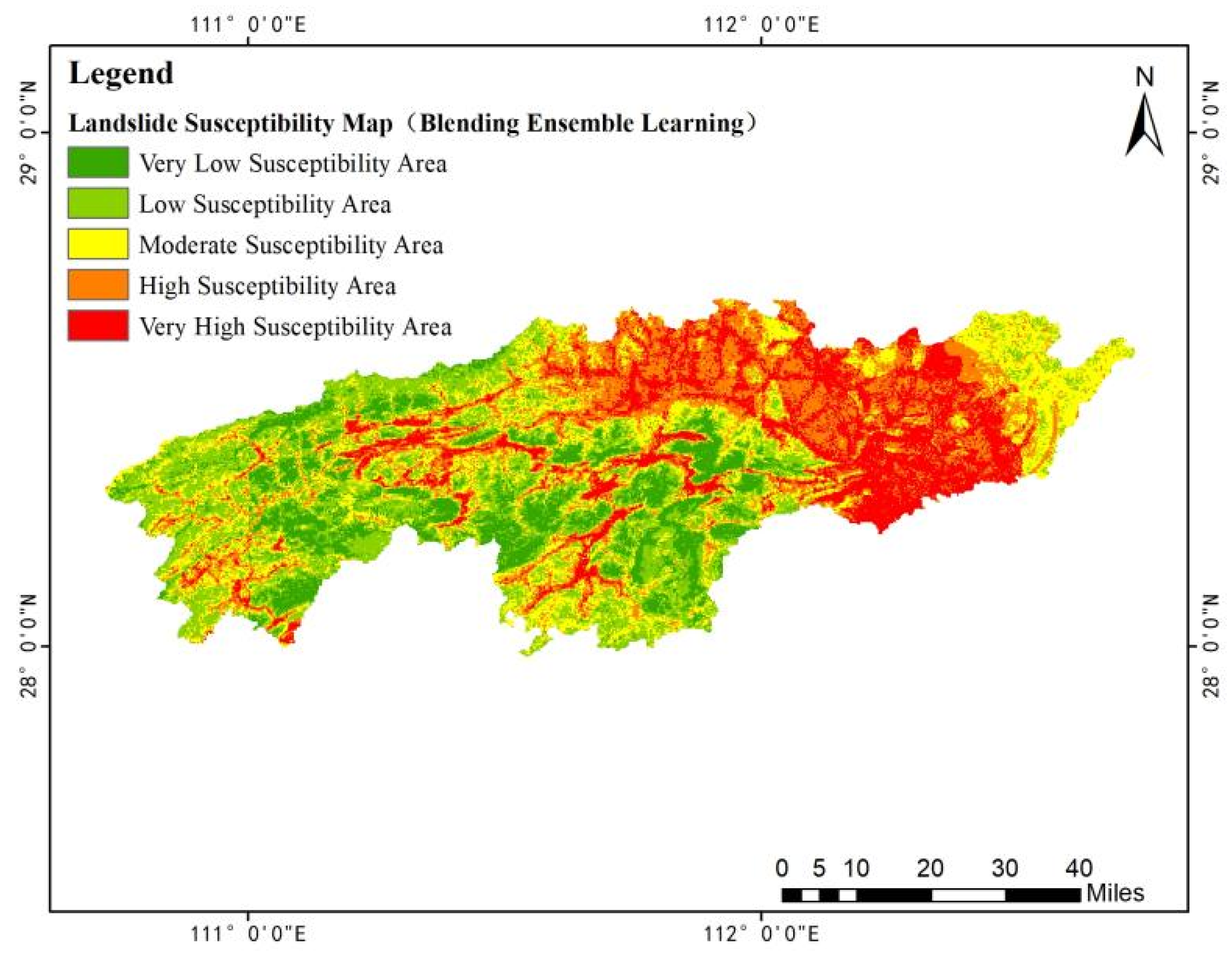

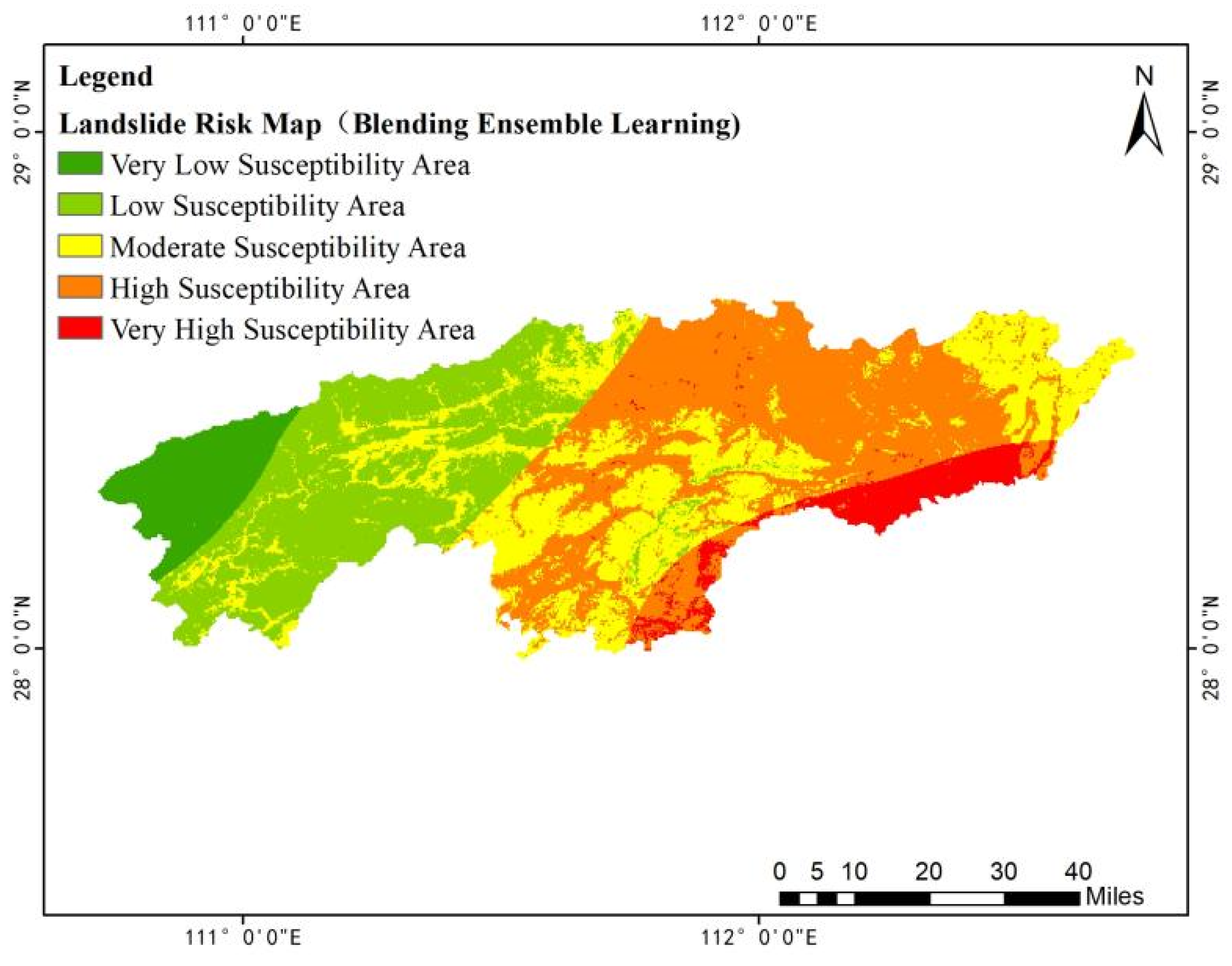

| Order No. | Data Name | Data Sources | Spatial Resolution | Data Types |
|---|---|---|---|---|
| 1 | Historical landslide points in Yiyang | Global Disaster Data Platform (https://www.gddat.cn/newGlobalWeb/#/home) (accessed on 10 January 2024) | Vector | document |
| 2 | Digital Elevation Model (DEM) | European Space Agency’s Copernicus (https://portal.opentopography.org/datasetMetadata?otCollectionID=OT.032021.4326.1) (accessed on 10 January 2024) | 30 × 30 m | Raster Grid |
| 3 | Normalized Difference Vegetation Index (NDVI) for Land Cover in Yiyang | Landsat 8 OLI Image provided by NASA & United States Geological Survey (USGS) Application-GloVis (usgs.gov) | 30 × 30 m | Raster Grid |
| 4 | “National 1:200,000 Scale Digital Geological Map Spatial Database [25] ” | Development Research Center of China Geological Survey Geological Cloud Platform 3.0 (cgs.gov.cn) | 1:200,000 | Raster Grid |
| 5 | “1:1,000,000 Soil Data of China” | Nanjing Institute of Soil Sciences, Chinese Academy of Sciences China Soil Database (csdb.cn) | 1:1,000,000 | Raster Grid |
| 6 | ERA5 Atmospheric Reanalysis Data (10-day rainfall) | European Centre for Medium-Range Weather Forecasts (https://cds.climate.copernicus.eu/cdsapp#!/dataset/reanalysis-era5-single-levels?tab=overview) (accessed on 10 January 2024) | 0.25° × 0.25° (atmosphere) | NetCDF |
| 7 | Watercourse Distribution Vector Data in Yiyang | Tianditu The National Geographic Information Public Service Platform (tianditu.gov.cn) | 1:250,000 | vector |
| 8 | vector data of Road distribution in Yiyang | Resources and Environmental Science and Data Center, Chinese Academy of Sciences Resource and Environmental science Data platform (resdc.cn) | vector |
| Factors | ||
|---|---|---|
| Model | Collinearity | |
| VIF | ||
| 1 | Slope | 2.069 |
| Elevation | 1.648 | |
| Distance to Fault | 1.306 | |
| Aspect | 1.078 | |
| Plan curvature | 1.276 | |
| Profile curvature | 1.397 | |
| NDVI | 1.376 | |
| Density of road network (km/km2) | 1.292 | |
| 10-day rainfall (mm) | 1.257 | |
| Distance to roads (m) | 1.429 | |
| Distance to rivers (m) | 1.364 | |
| DSN | 159.305 | |
| YSEB | 4.875 | |
| YSC | 2.140 | |
| YSD | 3.007 | |
| QDFCF | 151.244 | |
| a. Dependent Variable: Soil type | ||
| Factors | ||
|---|---|---|
| Model | Collinearity | |
| VIF | ||
| 1 | Slope | 2.063 |
| Elevation | 1.644 | |
| Distance to Fault | 1.261 | |
| Aspect | 1.075 | |
| Plan curvature | 1.274 | |
| Profile curvature | 1.397 | |
| NDVI | 1.372 | |
| Density of road network (km/km2) | 1.285 | |
| 10-day rainfall (mm) | 1.219 | |
| Distance to roads (m) | 1.427 | |
| Distance to rivers (m) | 1.363 | |
| DSN | 3.135 | |
| YSEB | 4.874 | |
| YSC | 2.140 | |
| YSD | 2.662 | |
| a. Dependent Variable: Soil type | ||
| Sample Size (2220) | Soil Type | DSN | YSEB | YSC | YSD | QDFCF | Aspect |
|---|---|---|---|---|---|---|---|
| Cardinality | 13 | 36 | 31 | 19 | 16 | 35 | 9 |
| PF | Importance Coefficients |
|---|---|
| Elevation | 0.166398 |
| NDVI | 0.136907 |
| Slope | 0.104169 |
| Plan curvature | 0.071519 |
| Profile curvature | 0.069768 |
| DSN | 0.068317 |
| Aspect | 0.065359 |
| Distance to faults | 0.065237 |
| Road density | 0.053942 |
| YSEB | 0.047011 |
| Distance to road | 0.040264 |
| YSC | 0.039642 |
| YSD | 0.030077 |
| Soil types | 0.023435 |
| Distance to rivers | 0.017955 |
| PF | Importance Coefficients |
|---|---|
| Elevation | 0.149948 |
| YSC | 0.091733 |
| NDVI | 0.088044 |
| DSN | 0.086265 |
| YSEB | 0.066175 |
| Distance to roads | 0.065074 |
| Distance to rivers | 0.055843 |
| Plan curvature | 0.055399 |
| Soil types | 0.055156 |
| Slope | 0.053915 |
| Profile curvature | 0.050946 |
| Distance to faults | 0.050121 |
| Road density | 0.047683 |
| Aspect | 0.044365 |
| YSD | 0.039332 |
| PF | Importance Coefficients |
|---|---|
| Elevation | 0.153182 |
| NDVI | 0.144482 |
| Distance to faults | 0.079307 |
| DSN | 0.078497 |
| Slope | 0.072615 |
| Plan curvature | 0.072276 |
| Profile curvature | 0.0614889 |
| Aspect | 0.059107 |
| Road density | 0.056349 |
| YSC | 0.052362 |
| Distance to roads | 0.044927 |
| YSEB | 0.038630 |
| YSD | 0.037964 |
| Soil types | 0.032415 |
| Distance to rivers | 0.016397 |
| PF | Importance Coefficients |
|---|---|
| Elevation | 0.155971 |
| NDVI | 0.116825 |
| DSN | 0.078708 |
| Slope | 0.074366 |
| YSC | 0.065887 |
| Plan curvature | 0.064489 |
| Distance to faults | 0.061751 |
| Profile curvature | 0.059429 |
| Aspect | 0.054520 |
| YSEB | 0.053629 |
| Distance to roads | 0.052439 |
| Road density | 0.051704 |
| Soil types | 0.039704 |
| YSD | 0.036049 |
| Distance to rivers | 0.034530 |
| Models | AUC | Accuracy | Precision | Recall | F1 |
|---|---|---|---|---|---|
| Random Forest | 0.8841 | 0.8045 | 0.8049 | 0.8390 | 0.8216 |
| XGBoost | 0.8572 | 0.7955 | 0.7874 | 0.8475 | 0.8163 |
| CatBoost | 0.8787 | 0.8000 | 0.7846 | 0.8644 | 0.8226 |
| Blending Classifier | 0.8784 | 0.8045 | 0.8000 | 0.8475 | 0.8230 |
| Predisposing Factors | Importance Coefficients | Cumulative Contribution (%) |
|---|---|---|
| Ten-day rainfall | 0.489018 | 48.9018 |
| Distance to rivers | 0.07703 | 56.6048 |
| Stratigraphic types | 0.076972 | 64.302 |
| Elevation | 0.057843 | 70.0863 |
| NDVI | 0.050007 | 75.087 |
| Distance to faults | 0.040647 | 79.1517 |
| Slope | 0.035335 | 82.6852 |
| Road density | 0.02963 | 85.6482 |
| Distance to roads | 0.024226 | 88.0708 |
| Aspect | 0.022568 | 90.3276 |
| Plan curvature | 0.018776 | 92.2052 |
| Profile curvature | 0.01817 | 94.0222 |
| Rock types | 0.017096 | 95.7318 |
| Soil types | 0.015737 | 97.3055 |
| Rock texture | 0.014454 | 98.7509 |
| Rock structure | 0.01249 | 99.9999 |
| Models | AUC | Accuracy | Precision | Recall | F1 |
|---|---|---|---|---|---|
| Random Forest | 0.9969 | 0.9773 | 0.9913 | 0.9661 | 0.9785 |
| XGBoost | 0.9974 | 0.9773 | 0.9748 | 0.9831 | 0.9789 |
| CatBoost | 0.9989 | 0.9818 | 0.9914 | 0.9746 | 0.9829 |
| Blending Classifier | 0.9983 | 0.9818 | 0.9831 | 0.9831 | 0.9831 |
| Prediction Model | Susceptibility Areas | Grid Number (Unit) | Area Ratios (%) | Landslide Ratios (%) | Landslide Density (per km2) | Frequency Ratios FR (Landslide Ratio/Area Ratio) |
|---|---|---|---|---|---|---|
| Blending ensemble learning | Very low S.A. | 13,120 | 13.32 | 1.57 | 0.008 | 0.118 |
| Low S.A. | 23,408 | 23.76 | 4.35 | 0.013 | 0.183 | |
| Moderate S.A. | 22,873 | 23.22 | 9.04 | 0.027 | 0.390 | |
| High S.A. | 21,412 | 21.73 | 29.39 | 0.095 | 1.352 | |
| Very high S.A. | 17,709 | 17.97 | 55.65 | 0.217 | 3.096 |
| Prediction Model | Risk Areas | Grid Number (Unit) | Area Ratios (%) | Landslide Ratios (%) | Landslide Density (per km2) | Frequency Ratios FR (Landslide Ratio/Area Ratio) |
|---|---|---|---|---|---|---|
| Blending ensemble learning | Very low R.A. | 7025 | 7.36 | 0.52 | 0.005 | 0.07 |
| Low R.A. | 24,673 | 25.89 | 8.35 | 0.023 | 0.322 | |
| Moderate R.A. | 25,931 | 27.21 | 12.52 | 0.032 | 0.460 | |
| High R.A. | 32,735 | 34.35 | 57.22 | 0.117 | 1.666 | |
| Very high R.A. | 4948 | 5.19 | 21.39 | 0.289 | 4.121 |
| Prediction Model | Susceptibility Areas | Grid Number (Unit) | Area Ratios (%) | Landslide Ratios (%) | Landslide Density (per km2) | Frequency Ratios FR (Landslide Ratio/Area Ratio) |
|---|---|---|---|---|---|---|
| Blending ensemble learning | Very low S.A. | 13,120 | 13.32 | 3.80 | 0.009 | 0.286 |
| Low S.A. | 23,408 | 23.76 | 14.45 | 0.020 | 0.608 | |
| Moderate S.A. | 22,873 | 23.22 | 21.67 | 0.030 | 0.934 | |
| High S.A. | 21,412 | 21.73 | 32.70 | 0.048 | 1.505 | |
| Very high S.A. | 17,709 | 17.97 | 27.38 | 0.049 | 1.523 |
Disclaimer/Publisher’s Note: The statements, opinions and data contained in all publications are solely those of the individual author(s) and contributor(s) and not of MDPI and/or the editor(s). MDPI and/or the editor(s) disclaim responsibility for any injury to people or property resulting from any ideas, methods, instructions or products referred to in the content. |
© 2025 by the authors. Licensee MDPI, Basel, Switzerland. This article is an open access article distributed under the terms and conditions of the Creative Commons Attribution (CC BY) license (https://creativecommons.org/licenses/by/4.0/).
Share and Cite
Hou, C.; Liu, H.; Wang, X.; Hu, J.; Tang, Y.; Yao, X. Landslide Susceptibility Analysis Based on Dataset Construction of Landslides in Yiyang Using GIS and Machine Learning. Appl. Sci. 2025, 15, 5597. https://doi.org/10.3390/app15105597
Hou C, Liu H, Wang X, Hu J, Tang Y, Yao X. Landslide Susceptibility Analysis Based on Dataset Construction of Landslides in Yiyang Using GIS and Machine Learning. Applied Sciences. 2025; 15(10):5597. https://doi.org/10.3390/app15105597
Chicago/Turabian StyleHou, Chengxun, Huanhua Liu, Xuan Wang, Jinqi Hu, Youde Tang, and Xunwen Yao. 2025. "Landslide Susceptibility Analysis Based on Dataset Construction of Landslides in Yiyang Using GIS and Machine Learning" Applied Sciences 15, no. 10: 5597. https://doi.org/10.3390/app15105597
APA StyleHou, C., Liu, H., Wang, X., Hu, J., Tang, Y., & Yao, X. (2025). Landslide Susceptibility Analysis Based on Dataset Construction of Landslides in Yiyang Using GIS and Machine Learning. Applied Sciences, 15(10), 5597. https://doi.org/10.3390/app15105597






